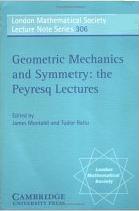 |
Geometric Mechanics and Symmetry: The Peyresq Lectures
J. Montaldi and T. Ratiu, eds.
London
Mathematical Society Lecture Note Series 306, Cambridge University
Press (2005) 412 pp., price USD 70.00
ISBN:0521539579
|
|
Reviewer: R. Ghrist, University of Illinois, Urbana-Champaign, USA.
|
Level: basic/intermediate.
This book is a compilation of lectures from two summer schools in
geometric mechanics in 2000 and 2001. The breakdown of the chapters
follows roughly the courses given in the summer, written either by
the lecturers or by coauthors. The chapters are as follows:
Stability in Hamiltonian Systems based on lectures by
K. Meyer.
This short chapter focuses on the restricted 3-body problem in
celestial mechanics. It builds up to a survey of known results about
stability of relative equilibria. This chapter is both elementary
and brief and provides a concrete frame for more advanced concepts
in geometric mechanics.
A Crash Course in Geometric Mechanics based on lectures
by T. Ratiu.
This long (130 page) chapter is the heart of the book. It serves as
a unified introduction to geometric mechanics and provides a basis
for the remaining chapters. This chapter is excellent: it is both
clean and terse. It is grounded in physical applications (the
spinning top, fluid flows, electromagnetism) and is mathematically
sophisticated. This chapter assumes an elementary background in
calculus on manifolds and the basics of Lie groups and Lie algebras.
The Euler-Poincare Variational Framework for Modeling Fluid
Dynamics based on lectures by D. Holm.
This article commences with a welcome excursion into geophysical
fluids. Motivated by problems in large-scale fluid flows, the author
gives an introduction to the Euler-Poincare equation of fluid
dynamics. This chapter is very rich, both in mathematics and in
applications. It includes further introductions to
Lagrangian-averaged fluid equations and a brief treatment of special
families of solutions: pulsons, peakons, and momentum filaments.
Many will find this article to be the most fascinating in the text.
No Polar Coordinates based on lectures by R.
Cushman.
This entertaining chapter is a survey of the work of R. Cushman.
The title is an inside joke taken from a comment by Duistermaat on
one of Cushman's books. This chapter is rich with examples and
illustrations, and is an ideal introduction.
Survey on Dissipative KAM Theory Including Quasi-Periodic
Bifurcation Theory based on lectures by H. Broer.
This article considers a version of KAM theory for vector fields on
tori. The novelty of this article is that dissipative dynamics are
considered. This makes for a simpler presentation than one normally
finds in papers on KAM theory.
Symmetric Hamiltonian Bifurcations based on lectures by
J. Montaldi.
This short article gives an introduction to results on Hamiltonian
bifurcations, including a nice treatment of the Hamiltonian-Hopf
bifurcation. The section on generic bifurcations of equilibria is
well-illustrated. The article ends with explicit applications to the
dynamics of point vortices on the sphere.
Surprisingly, the text is fairly unified, thanks in no small part to
the second chapter. There is nice balance of mathematical techniques
and applications. The general lack of proofs makes this text not
entirely suitable for a graduate course in geometric mechanics. It
would make a nice supplementary text for such a course, and would
likely be an excellent introduction.